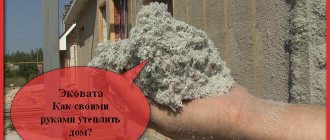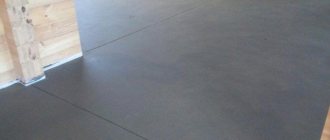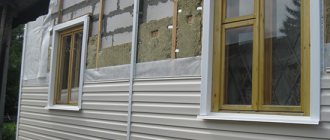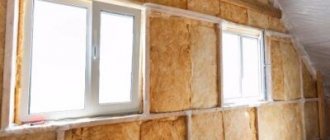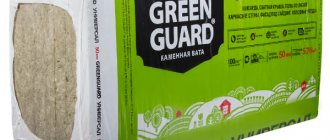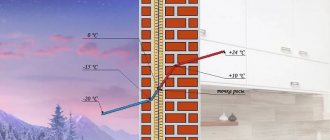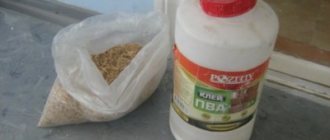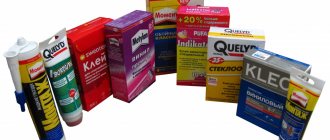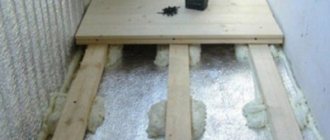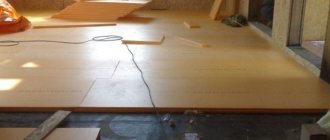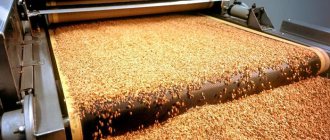When renovating an apartment or building a private house, special attention is always paid to the floor. It should be pleasant when walking barefoot, i.e. warm. This condition of the floor covering is achieved with the help of thermal insulation work.
Floor insulation can be done using two technologies:
- under the screed;
- by lags.
Almost all types of insulation are suitable for this. Each of them has its own insulation technology.
Continuing the series of articles on the types of insulation and the features of the technological process of insulating various structural elements of a building with different thermal insulation materials, the editors of the StroyGuru website introduce its visitors to how mineral wool is used for floor insulation.
Pros and cons of mineral wool insulation
The class of mineral wools is represented by glass wool - made from cullet, basalt wool - natural basalt fibers, slag wool - made from waste from the metallurgical industry. However, only glass and stone wool can be found on sale. Slag wool is not used in residential construction due to the formation of hydrochloric acid when wet.
Each type has its own characteristics, physical and technical indicators, strengths and weaknesses. At the same time, advantages and disadvantages can be both general and individual.
General advantages include :
- excellent thermal insulation properties;
- versatility;
- resistance to high temperatures;
- biological resistance;
- low specific gravity;
- convenient transportation;
- simple insulation technology;
- environmental friendliness;
- fire resistance.
Among the negative aspects, experts note:
- presence of connecting seams;
- increased dust formation.
If we consider glass wool and basalt fiber separately, then basalt wool has several strengths that its competitor does not have:
- long service life;
- low hygroscopicity;
- good noise absorption;
- resistance against rodents;
- inertness to most chemicals;
- high degree of elasticity and strength.
The only downside is the high cost.
For glass wool, on the contrary, the price relates to its advantages - it is affordable, i.e. accessible to a wide range of consumers.
The list of individual disadvantages of glass wool is much longer:
- high hygroscopicity;
- short operational period;
- attractive to rodents;
- entering into a chemical reaction with almost all alkalis.
More detailed information about the pros and cons of mineral insulation is given in the material “Mineral wool for insulation”. Here you can get acquainted with the characteristics of insulation based on glass and basalt and performance indicators.
Conclusion
As you can see, it is easier to do the insulation of the foundation with penoplex yourself than to do the same with expanded clay. But expanded clay will cost you much less. The photos and videos in this article show the main points of the process. If you have any questions, write them in the comments and we’ll talk.
Bonding insulation to waterproofing.
Which mineral wool to choose for floor insulation
The quality of thermal insulation depends mainly on the correct choice of insulation. The key parameters are thermal conductivity, thickness and density of the material, and service life.
Thermal conductivity. On the first floors of apartments, floors on the ground and screw piles, it is advisable to use insulation with a thermal conductivity coefficient of 0.035-0.037 W/(m×°K). Only basalt wool corresponds to this indicator value. Glass wool can be effectively used on the second and higher floors, as well as for thermal insulation of the floor above the ground, insulated with expanded clay.
Thickness. In a country house with irregular visits, floors in technical rooms, residential buildings in the southern regions of the country, a thickness of 50 mm is sufficient when insulating along joists. Mats of the same thickness should be used in high-rise apartments. But here other factors impose restrictions: the height of the ceilings.
In northern latitudes, floors above the basement and directly on the ground, when logs are laid on ground that has been previously waterproofed, slabs with a thickness of 200 mm are considered the ideal option.
Mats 5 cm thick are laid under the screed. There is also a height limitation, since a floor cake that is too large will eat up a significant volume of the room.
Attention: if a mat thickness of 50 mm is not enough to insulate the floor, it is better to abandon the screed and use logs.
Density of the material. For insulation along joists, rolls or sheets with a density of 35-40 kg/m3 for glass wool and 50-60 kg/m3 for basalt wool are sufficient.
To insulate floors on the ground, you need basalt wool with a density of 135-150 kg/m3 (thermal conductivity values are as low as possible), for screed - 150-175 kg/m3 (good rigidity).
Durability. Basalt wool is purchased for flooring with a service life of more than 20 years and for screed. In other cases, you can insulate with glass wool.
It is necessary to purchase mineral insulation from proven suppliers. These can be famous brands and manufacturers unknown to a wide range of buyers. Among the rating leaders:
Rockwool. Danish manufacturer of mineral wool "Rockwool". Supplies basalt and gabbro products to the construction markets of Russia and countries from the former Soviet Union. It has its own production facilities in many countries of the world, including Russia. The products are distinguished by high quality and reasonable prices.
Paroc. The Finnish company offers consumers slabs of basalt and glass for housing construction and acoustic insulation of recording studios. The insulation is characterized by excellent thermal insulation properties, fire resistance, and a long service life. For consumers with average incomes, the cost of insulation is too high.
Isover. Isover (France) owes its leadership in the sales market to the best ratio between the price of the product and its quality.
TechnoNIKOL. The manufacturer of domestic mineral wool insulation, has organized production in many countries (Lithuania, Belarus, Czech Republic, England). The consumer is offered a wide range of good quality insulation materials.
IZOVOL. Under the IZOVOL trademark, basalt wool insulation is produced. The production is purely Russian. The product has a budget price and good quality
In addition to the listed brands, it is worth paying attention to the brands “KNAUF” and “URSA”, as well as the insulation “Beltep” (Belarus). The Belarusian manufacturer has excellent rigidity, easy installation, and an affordable price.
General information
The thickness of the material is selected depending on the climate of the region. One indicator is provided for the northern republics, and another for the southern republics.
Firstly, the thicker the insulation, the better the heat is retained, and the less energy is spent on heating. Secondly, insulation also saves you from heat. Thirdly, insulation is a good sound insulator.
The thickness varies depending on the type of floor and its location. The floor of the first floor is the coldest, especially if the house is on stilts and is ventilated from below. But it can be earthen if the foundation is strip, and concrete if it is slab.
The floors between floors are heated on both sides. Insulation is used only as sound insulation.
The attic floor is also a floor. It must be insulated, especially if the attic is unheated. Otherwise, the heat will go outside, and in addition condensation will appear on the ceiling.
Insulation thickness under a heated floor system
Each material has its own thermal conductivity coefficient. This parameter is of primary importance when determining the thickness of insulation.
Thermal conductivity of insulation of different densities
The effectiveness of insulation also depends on the density. The higher it is, the more difficult it is for the insulator to retain heat.
Comparison of thermal conductivity of materials
12 cm of polystyrene (density, however, not indicated) will retain heat as effectively as 210 cm of solid red brick.
Required materials and tools
To insulate the floor with mineral wool under the screed and along the joists, you need to purchase basic and auxiliary materials on the construction market, as well as complete a set of tools (borrow from friends or neighbors, rent from specialized companies).
Materials you will need:
- mineral wool for floor insulation;
- logs made of well-dried timber;
- sheets of OSB, plywood or gypsum fiber board - laid on logs under laminate, parquet, ceramic tiles;
- wood screws 3-4 cm long for attaching the log to a metal corner or U-shaped profile;
- self-tapping dowels - the corners and profile are attached to the concrete base of the floor;
- U-shaped metal profile, studs or corners - connect the logs to the floor slab;
- primer;
- waterproofing materials (polyethylene film, roofing felt, mastics, etc.);
- metallized tape;
- vapor barrier film or membrane.
The list of necessary tools:
- perforator;
- screwdriver with cross bits;
- jigsaw or wood saw;
- roulette;
- construction knife;
- level;
- marker or construction pencil;
- construction stapler.
Instructions for floor insulation with mineral wool
Several instructions have been developed for insulating the floor with wool made from glass and basalt fibers:
- insulation of the floor with basalt wool under the screed;
- floor insulation along joists on a concrete base;
- floor insulation along joists in a wooden house.
Insulation under the screed
The high compressive strength of basalt mats makes it possible to lay them under a screed. With this insulation technology, the effectiveness of thermal insulation depends not only on the insulation, but also on the quality of the preparatory work carried out. Here you need to perform the following operations:
- using a hammer drill, remove the old screed (it will take several days to remove it manually), since cracks and potholes appear on it due to time and operational loads;
- the concrete floor is removed from debris and dust. The garbage is put into bags, and the dust is removed with a construction vacuum cleaner;
- after wet wiping, the base of the floor is inspected to identify defects;
- the identified damage, as well as the connecting seam between the floor slabs, are sealed with a repair compound. To improve the adhesion of the cement mortar to the floor concrete and prevent the growth of cracks, all damaged areas are poured with cement “military” or primed with a deep penetration primer, small cracks are expanded, large cracks are reinforced.
After the repair mortar has completely dried, the base of the floor over the entire surface is primed twice, preferably with Concrete Contact. At the next stage, work is carried out to protect the insulation from moisture, which forms in the form of condensation on the surface of the concrete floor. The work can be performed with any waterproofing material. The process of waterproofing a concrete base is described in detail in the work “Waterproofing the floor before screeding”.
Basalt mats are laid on top of the waterproofing layer. In this case, each subsequent row is mounted with a shift so that the transverse connecting seams do not coincide. This is the so-called “staggered” laying or, as it is also called, brickwork.
The joints are taped with metallized tape. A reinforcing mesh is attached on top of the mats. To fix it, you can use CERESIT CT190 glue.
Attention: more complete information on preparing the subfloor for insulation is given in the material “Preparing the subfloor for floor screed.”
The screed is poured onto the dried glue.
Insulation of concrete base along logs
The technology of insulation using joists for a concrete base consists of preparatory work, waterproofing the floor, installing joists, insulation, and vapor barrier of the insulating layer.
The preparation of concrete for insulation is discussed a little higher, in the previous section. Therefore, we will break the order of considering the technology and go straight to laying the logs. You can do this using:
- U-shaped profile;
- hairpins;
- battens.
The timber is attached at a distance of 2-3 cm from the wall and 50-60 cm between each other.
The instructions for attaching the joists to the concrete base are discussed in detail in the material “Insulation of the floor on the balcony.”
Mineral wool with mat sizes 5-10 mm larger than the cells is laid between the lags so that the installation is done by surprise. In this case, the logs should be 4-6 cm higher than the insulation to form a ventilation gap.
The insulation and logs are covered with a vapor barrier film, overlapping the walls by 10-15 cm (all excess will be cut off after installation of the floor covering). The canvases should overlap each other by about 20 cm. The seams are taped.
Insulation of floors along joists in a wooden house
Work is carried out a little differently in a house made of timber. Therefore, we will consider in more detail how to insulate a floor with mineral wool in a wooden house.
Preparatory work
The technological process of insulation using joists begins with the removal of the old floor. If the elements of the floor covering can be indestructibly dismantled, then they are marked and folded separately. After this, construction debris and dust are removed from the subfloor (vacuumed or washed with a slightly wrung-out cloth).
Surface repair
Subfloor boards must meet the following requirements:
- have no rot;
- be firmly fixed to the cranial bars;
- do not creak;
- do not bend;
- have no traces of grease, paint or glue.
Disadvantages are eliminated:
- rotten and sagging boards are replaced;
- contaminated areas are washed or treated with a plane;
- loose boards are attached to additional screws;
- cracks and fallen knots are sealed with wood dust putty or oil paint with the addition of sawdust - proportion 1 to 4.
Waterproofing
Waterproofing work is carried out on the repaired subfloor, protecting the insulation from moisture from below. Instructions for carrying out this type of work are described in detail in the article “Waterproofing a wooden floor.”
Installation of mineral wool
Cotton wool is cut to fit the size of the openings between the joists, with an addition of 1 cm around the perimeter. The reserve allows you to lay the insulation boards without gaps, by surprise. When laying 2 layers, the layout of the slabs provides for their shift by a few centimeters so that the second layer covers the joints of the lower slabs. This is the so-called bricklaying method.
The connecting seams are taped.
Vapor barrier
The mineral wool together with the logs is covered with a vapor barrier membrane. The film is laid with an overlap of up to 20 cm, and overlaps the walls by 10-15 cm. The connecting seams are sealed with tape.
Ecowool as a type of attic insulation
A type of cotton wool is ecowool, light, loose to the touch, consisting of ordinary newspapers.
The binding components are borax and boric acid; they also extinguish flames remarkably well. Insulating an attic with ecowool looks like this:
- Spread the film on the ceiling and equip yourself with blowing equipment.
- Your task is to lay the wool in an even layer, without gaps or cracks.
- Maintain a layer thickness of at least 250-300 mm.
- Taking into account rapid shrinkage, take a layer with an excess of up to 50 mm.
- At this point, the insulation of the attic can be considered complete; the only step left is to moisten the surface. A mixture consisting of PVA glue and 1 bucket of clean water is suitable for this. If there is no glue, you can use only water.
- Humidification occurs by wetting the broom in water and spraying water over the surface.
- When the material dries, you will see how its surface has taken on a crust; builders call it lignin. It provides ecowool with a primary appearance and prevents displacement and deformation.
